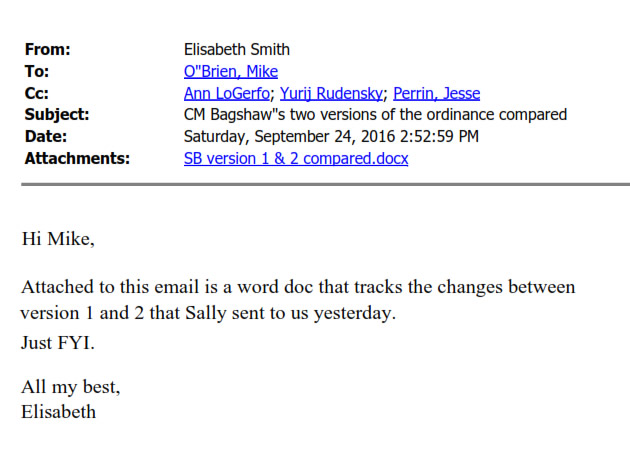
David Preston
June 5, 2017
What would you think if you discovered automobile executives had written a bill on auto safety and handed it to your senator to sponsor? And what if you learned those same executives had penned pro-industry letters to the editor for your senator to send to the local newspaper under his signature? No self-respecting American would tolerate something like that. But substitute ACLU for “automobile executive” in this scenario, and substitute “a bill on homeless encampments” for “a bill on auto safety” and you’ll have an approximation of what happened at the Seattle City Council last fall.
A serious problem
Homeless encampments on public land have been a troublesome issue in Seattle for several years. Some citizens think the camps need to go, some don’t mind if they stay. However, as the number of camps has grown and expanded across the city, the balance seems to be shifting in the “need to go” direction. After a multiple homicide at one camp in late January 2016, Mayor Ed Murray declared the camps to be a nuisance and said the City would begin “sweeping” them shortly.
Some members on the Council (notably Mike O’Brien, Lisa Herbold, and Sally Bagshaw) didn’t like that kind of talk. They said it was a violation of homeless people’s rights to forcibly remove them, possibly destroying or losing their possessions in the process. Two powerful civil rights groups (the American Civil Liberties Union (ACLU) and Columbia Legal Services (CLS)) joined the battle on the councilmembers’ side. The groups vaguely threatened to take action against the Mayor if he moved forward with the sweeps. Elizabeth Smith, Legislative Director of the Washington State ACLU, offered to help CM Sally Bagshaw draft a bill that would stop the Mayor in his tracks. Eventually, other CMs were recruited to the project and it began to pick up steam.
There is no evidence that the any of the CMs involved in this effort told the Mayor what they were up to, and Murray was likely unaware, because in mid-May, he announced that he would move ahead to sweep encampments. The ACLU then stepped up their game and publicly threatened to sue the city. In view of that threat, which was followed promptly by a draft resolution of opposition to Murray from Councilmember Sally Bagshaw, the Mayor backed down and announced that he’d postpone the sweeps and create a task force to study the matter further.
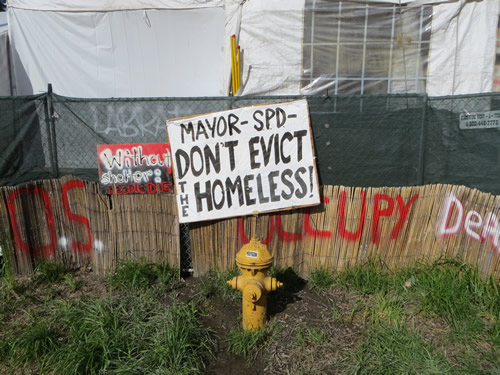
February 2016: A sign posted in front of the “Nickelsville” homeless camp in downtown Seattle urges the mayor and police not to remove the camp. Photo: David Preston
A proposed solution
Sometime between late May and early September, the ACLU and Columbia Legal Services began working more closely with the City Council on the legislation, with the ACLU’s Smith taking the lead. Some five weeks later, on October 10, the parties had a draft bill that was satisfactory to all. The proposed ordinance was assigned a number (CB 118794) and was entitled:
AN ORDINANCE relating to City responses to people who are homeless living on public property; setting standards and procedures for remedying unsafe conditions and protecting the rights and property of homeless individuals.
The bill’s procedural history can be found on the City Council’s official Web site here.
The ACLU bill divided encampment areas into four basic “situations”:
- Unsafe locations
- Unsuitable locations
- Locations with hazardous conditions, and
- Safe and suitable locations without hazardous conditions
For the first two (unsafe and unsuitable), the ordinance would allow the city to remove encampments, but only after the city had given the campers 48 hours’ notice and had identified an “alternative site” for them to move to. This alternative site could be another homeless camp (a “safe and suitable one”) or some other form of housing, such as a shelter or residence motel. For situations with “hazardous conditions” such as large amounts of human waste or needle trash, campers would be given 72 hours to remedy the hazard, and if they failed to do so they could be moved after another 48 hours’ notice. In that one instance, the City would not be compelled to find them an “alternative site.”
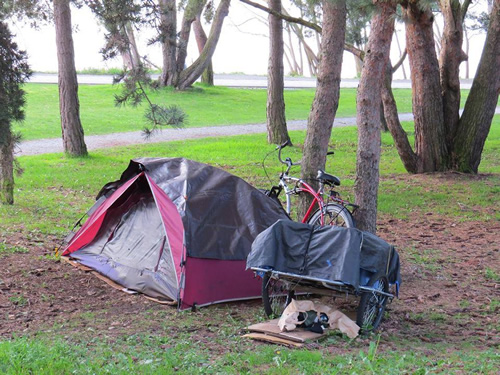
This is one of several tents that popped up in Seattle’s historic Green Lake Park in the spring of 2017. Under the ACLU’s ordinance, these campers would have been allowed to remain here until the City found them “adequate and accessible” housing. Photo: Safe Seattle
For those campers at a “safe and suitable location,” the City could remove them only after giving them 30 days’ notice, during which time the City would have to offer them “adequate, accessible housing” and other services, such as addiction and mental health counseling.
The document below is a summary of how ACLU/CLS wanted the City to handle encampments. You can enlarge the document using the viewer tools at the bottom of the frame:
Another document submitted in September 2016 and probably authored by the ACLU and CLS is entitled “Guiding Principles.” It gives a sense of the purpose behind the legislation.
Who wrote the bill?
Acting on a tip from inside City Hall, I did a public disclosure request for correspondence between the ACLU and Seattle councilmembers, and some of that material is included below, along with my annotations. The chain of documents tells a story of how the encampments bill was essentially written for the Council by the ACLU, which colluded with CM Mike O’Brien and his aide Jesse Perrin to keep other potentially interested parties out of the discussion. Besides the ACLU and CLS, there were designated “stakeholders” who were consulted occasionally, but these were people who were likely to support the ACLUs position on homeless people living in parks. They included homeless advocates like Tim Harris, publisher of the Real Change street newspaper, and Lisa Daugaard, who founded a law enforcement diversion program that advocates for homeless heroin addicts. A handful of downtown business groups were also included in the Cc list as well, but there was no one from the Parks Department, any environmental group, or any neighborhood that was actually being impacted by homeless people living in City parks.

O Captain! My Captain! Elisabeth Smith is the Legislative Director of the WA chapter of the ACLU. She and Ann LoGerfo of Columbia Legal Services wrote an ordinance that would have allowed homeless people to live in Seattle parks indefinitely. Photo: ACLU of Washington State
Document 1 : Get with the program, Sally
This is a three-page e-mail chain from early September 2016. In the original e-mail, CLS’s Ann LoGerfo scolds Sally Bagshaw for not following through on her initial pledge to sponsor and push the ordinance. Click the down arrow in the frame to page through the document:
Document 2: Already headed for a win
This is a three-page e-mail chain ending on September 22. It is rich in clues to the involvement of the ACLU in the encampments legislation. Read from the bottom to the top. Click the down arrow in the frame to page through it:
Document 3: Finding Consensus
This September 23 e-mail from CM O’Brien’s aide Jesse Perrin to the stakeholders shows that neighborhood groups, and others who might have moderated the bill’s tone, were notably absent from the discussion.
Document 4: All my best, Elisabeth…
On September 24, ACLU Legislative Director Smith forwarded to CM Mike O’Brien a change-tracked version of the Draft Encampments Ordinance. Who made the various changes in the document is not clear; however, the fact the document was in Ms. Smith’s possession may be inferred as proof that Ms. Bagshaw was at least consulting with Smith on the wording. Click on the image below to read the document. Or click here.
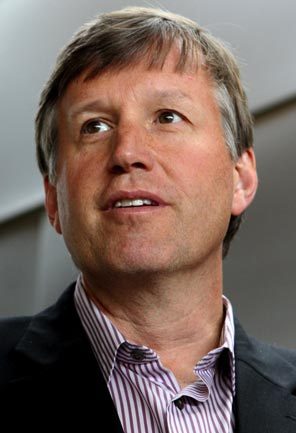
Cabin Boy. Seattle Councilmember Mike O’Brien sponsored the ACLU encampments ordinance and published a Seattle Times op-ed piece that CLS’s Ann LoGerfo told him to write. Or wrote for him. Photo credit: Seattle Times
Document 5: Misinformation Campaign
On September 29, 2016, Smith attended a “community meeting” held by CM O’Brien in his Ballard district. (It was one of several meetings I covered in my investigation of how O’Brien packs his meetings with supporters.) One of the topics discussed at the meeting was the encampments bill, but it’s not clear whether Smith identified herself to the Ballard residents as being the author of the billl:
Columbia Legal Services’ Ann LoGerfo was at the meeting as well. She did not identify her connection with CLS until she was outed by another person at the meeting (see below).
Document 6: Finalizing the text
On October 7, the ACLU’s Smith invited CMs Bagshaw, O’Brien, Herbold, and Johnson, and several of their aides to a meeting to put the finishing touches on the ordinance language. By now it’s clear that the Smith, not the Council, is directing the project:
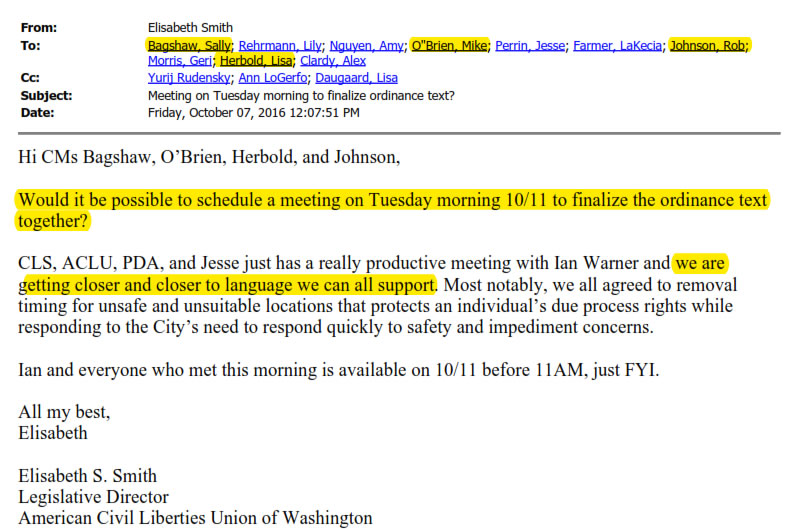
Document 7: Yet another draft
By October 10, the ACLU’s Elisabeth Smith was still finding things wrong with the language in CM Bagshaw’s version of the ordinance. From the level of detail and tone of her remarks, it appears that Smith may have gotten pushback from Bagshaw on some of her suggested language. Nevertheless, Smith seems to be insisting on right to continue steering the process until the end:
The draft Bagshaw document with Smith’s suggested changes is here.
Document 8: One more draft and an op-ed
Seven hours later on that same day of October 10, 2016, O’Brien’s aide Jesse Perrin announces that he’s made his best effort to “incorporate the consensus language” from “multiple stakeholders.” This is the last reference to any draft versions of the ordinance that I have. I don’t have the document that Perrin referred to, but presumably it was very close to the final O’Brien version offered on the Council’s calendar:
Perrin is also letting the recipients know that CM O’Brien has just gotten an op-ed supporting the encampments ordinance published in the Seattle Times, as he was instructed to do back on September 22nd (see Document 2 above). You can read O’Brien’s op-ed here. As with the ordinance, it’s likely that the op-ed was written for Mr. O’Brien by Ms. Smith or Ms. LoGerfo. Or both.

First Mate. Ann LoGerfo of Columbia Legal Services scolded CM Sally Bagshaw for not working more closely with her. She also offered to write an op-ed for Mike O’Brien and other CMs to send to the Seattle Times. Photo: Columbia Legal Services
Finishing up
The last hearing on Ordinance 118794 was the morning of September 14, 2016. Until that meeting, it had looked like there was at least moderate support for the bill among the public. Or at least, that’s the message the ACLU’s Smith had been giving out. On the strength of that feeling – combined perhaps with a sense of the inevitability of any legislation framed as progressive and compassionate– Smith might have thought she could bring CM Bagshaw around and they could reconcile their different versions of the bill. The Council could then hand the Mayor a bill. But it wasn’t to be. As the hearing got underway, it became apparent that the various City officials who’d been called to testify didn’t feel great about it. At the end of the expert testimony, CM Kshama Sawant stood up and made a somewhat off-topic speech about her proposal for the City to build a thousand new homes. That set a handful of people in the audience to booing, and meeting chair Bagshaw had to step in and restore order. It was not a good omen.
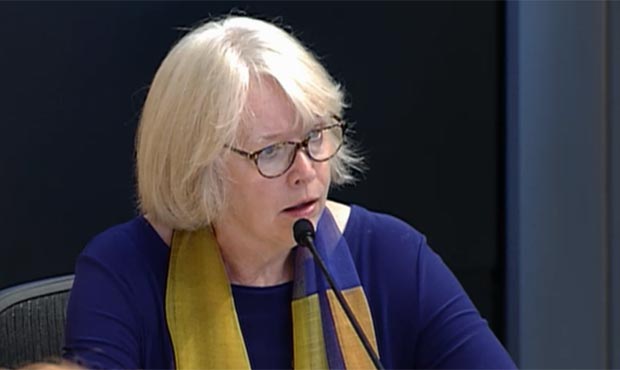
Mutineer. CM Sally Bagshaw invited the ACLU on board to stop the Mayor’s encampment sweeps but balked when the group tried to take over the reins. Photo: Seattle.gov
When Bagshaw finally turned the mic over for public comment, by some strange coincidence Elisabeth Smith was the first to speak. However, at no time during her two minutes of testimony did Smith say that she had been working with Council since January on the ordinance and that she had, in fact, written it for the Council. All Smith said was that she and the ACLU were pleased that Mayor Murray had “adopted the good ideas of CMs O’Brien, Herbold, Johnson, and Sawant” – leaving Bagshaw herself conspicuously off the list.
After Smith testified, several citizens spoke in favor of the ordinance, or at least the idea behind it. A tearful mom, her young children in tow, urged the Council to take pity on the poor. A homeless camp boss evinced righteous outrage at not being allowed just to live. Representatives of homeless service agencies then stepped forward to urge more support (read: more money) for their programs.
When the pro- side was done, the anti- side came up to speak, and here was the first proof of how badly the ACLU and O’Brian had erred in failing to take the neighborhoods into account. These were the people who were already bearing the brunt of the Council’s homeless policies. And they were angry. The denouement came when a neighborhood activist named Elisabeth James stepped to the mic and presented the Council with of box filled with reams of paper. A few days earlier, when James learned the City Council was contemplating the possibility of letting homeless people live in parks, she posted a petition online and publicized it through the Safe Seattle Facebook page. That petition garnered 20,000 signatures, which James then printed up for added impact.
This level of opposition to a feel-good type proposal was unprecedented in the history of the Council. Rather than risk a humiliating loss, Bagshaw and O’Brien decided to lay the bill on the table, where it stayed.
Below is a video of the final public hearing, but if you want to jump to some highlights, the ACLU’s Elisabeth Smith is speaking at 1:45:45. Elisabeth James, the woman with the 20,000-signature petition against the ordinance, is speaking at 2:45:30.
Post-game Analysis: Why the Encampments Ordinance failed
Depending on how cynical you are, you could see CB 118794 either as a good-faith effort to force the City to house the homeless or as a poison pill designed to stop the sweeps and nothing more. So which is it?
Nominally, the ordinance would have encouraged the City to find “adequate and accessible” (and presumably free) housing for everyone who showed up in a park. But it didn’t specify what “adequate and accessible” meant. Nor did it define what would be reasonable grounds for a homeless person to refuse that housing. Did “adequate housing” mean a “wet” shelter or apartment building in which residents could continue drinking and drugging? Did it mean a place that was big enough for a couple? Or one that allowed pets? No one knew.
And how would the 30 days of required outreach be measured? Would there be one clock that would be ticking for the whole camp? What about people who arrived at the camp after it started? No one knew, because the ordinance didn’t speak to that.
An insider who was involved with the process told me she thought the ACLU legislation was an honest attempt to remedy the problem of the City shuffling homeless people from place to place without giving them better options. The idea behind the bill, she said, was to shine a bright light on the problem of inadequate housing and services and to cause effort to be concentrated on remedying it. She believed the ACLU and Columbia Legal Services had to turn to the Council to get a bill written, “because Mayor Murray had ignored the administrative rules and declined to work with community critics.”
How realistic is it to believe that the City could or would provide “accessible and adequate housing” to everyone who showed up in a Seattle park looking for a place to stay? Wouldn’t that be a draw for still more homeless people to come here? Seattle is already a big draw for homeless people, even without the promise of free housing.
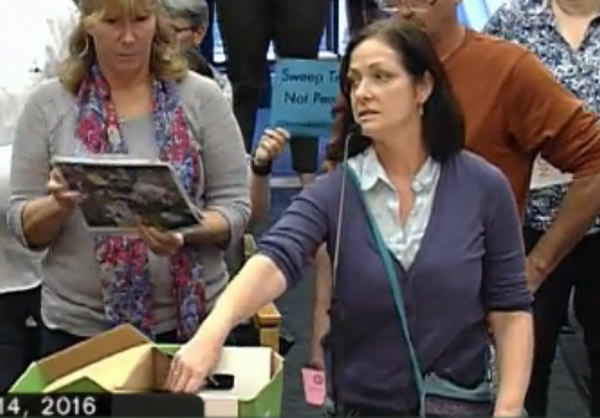
Pirate Jenny. Ballard resident Elisabeth James presents a box full of signatures to Mike O’Brien and the Council at the encampments bill’s final hearing. James had gathered 20,000 signatures on her petition to stop the bill. Photo: Seattle.gov
My inside source opined that it was not some flaw in the bill’s logic but rather the lack of neighborhood engagement that doomed it. But how could neighborhood groups have been involved in such a project in the first place? What neighborhood group would have bought off on the ACLU’s idea of letting homeless people camp in their local park? Neighborhood and environmental groups would surely have demanded the right to make changes to the bill’s language as the price of supporting it, and that is likely why O’Brien and Smith didn’t include them in the process. Considering that the ACLU’s Smith wouldn’t tolerate even minor variations suggested by CM Bagshaw, what was the likelihood of her letting some Friends of the Park-type group put her bill through the grinder?
In the end, the bill was doomed by the ACLU’s political obtuseness. Smith erred when she chose CM Mike O’Brien as front-man for the project. The same qualities that made him such a likely proxy (he’s a gentle man, soft spoken and pliable) rendered him incapable of taking the fight over this controversial bill to the people, or even carrying the other social justice enthusiasts on the Council. Smith erred again in trying to high-hand Sally Bagshaw, whose church-lady demeanor belies a political shrewdness Smith didn’t count on when she was clumsily trying to build an anti-Bagshaw, pro-Smith coalition on the Council.
But perhaps Smith’s biggest mistake was thinking that a traditionally outsider group like the ACLU could parachute into the Seattle City Council with a sweeping piece of social engineering and ram it through to approval in a matter of months. Seattle’s put up with some radical lurches from the Council, but this would’ve been too much. Had the ACLU-written bill passed, it would have met with a storm of resistance, and even O’Brien knew it. The irreconcilable differences between Bagshaw and O’Brien must have come as a relief to the others, since it gave them an excuse to walk away from the whole mess.
To return to my analogy with the auto industry writing auto safety legislation… What happened here might not have been illegal, but it was clearly a subversion of democracy. With the ACLU, we saw a private organization, unelected and not responsible to anyone, not only writing legislation but trying to control the way it was deliberated upon. And they almost got away with it, too.
This article is dedicated to Elisabeth James and the people of Ballard, Washington.
Postscript & Notes
When the Council failed to move Elisabeth Smith’s ghostwritten legislation forward, an emboldened Mayor Murray decided to pick up where he’d left off. In late January of 2017, City crews resumed removing encampments and the ACLU, making good on its threat from the previous sued the City in federal court for an injunction. The injunction was not granted and the ACLU has not returned to court to pursue it. Meanwhile, the sweeps continue apace. For analysis of the ACLU’s January 2017 suit, go here: ACLU vs. The People and here: Brandie Bright and Dark.
Elisabeth Smith of the ACLU and Ann LoGerfo of Columbia Legal Services are paid lobbyists registered with the Washington State Public Disclosure Commission. (Click on their names for details.) Both were invited by CM O’Brien to attend “community meetings” in the Ballard neighborhood O’Brien represents, even though though they don’t live in Ballard. O’Brien had asked the women to be discussion facilitators at the meeting, along with several other lobbyists and O’Brien supporters from outside the district. The job of the facilitators was to steer community comments and discussions into approved channels and to suppress comments that didn’t support the ACLU encampments legislation.
A woman who attended a meeting held in late September (while the ACLU was still pushing the legislation at City Hall) described to me what happened:
When the group discussions began on safety issues, homelessness, and supervised injection sites, the two latest additions to our table started interrupting people and talking over them., repeatedly telling us we were “not informed.” [O’Brien aide Jesse Perrin] did not stop them, but when someone interrupted one of them, he would say, “Let her speak now.” It became clear very soon after that all three were basically there to tell us why our thoughts were wrong. I looked up younger woman who had a name tag using my smart phone. Ann LoGerfo, it turned out, was an attorney from Columbia Legal Services. . . . When Ms. LoGerfo advised the group that it was not illegal to set up camp anywhere because of a DOJ decision, I then asked Ms. LoGerfo if she lived in District 6. She said no, but stated she was from the Pioneer Square area* and had a right to be there. She did not add that she was with Columbia Legal. I responded that I thought this was a meeting for District 6 neighbors to discuss their concerns.
I asked both Smith and LoGerfo to comment for this article. They did not respond. I tried to contact Councilmembers Bagshaw and O’Brien, as well as O’Brien’s aide Jesse Perrin. Of those three, Perrin was the only one who responded. He told that neither he nor O’Brien would comment for this article. I tried contacted several of the “stakeholders” that Perrin had mentioned in one of his e-mails. None of them responded.
For a more detailed examination of how Mike O’Brien uses paid advocates to steer his community meetings, see my article “The Hidden Persuaders.”
*Ms. LoGerfo doesn’t live in Pioneer Square either. She lives in the tony Windermere neighborhood.
